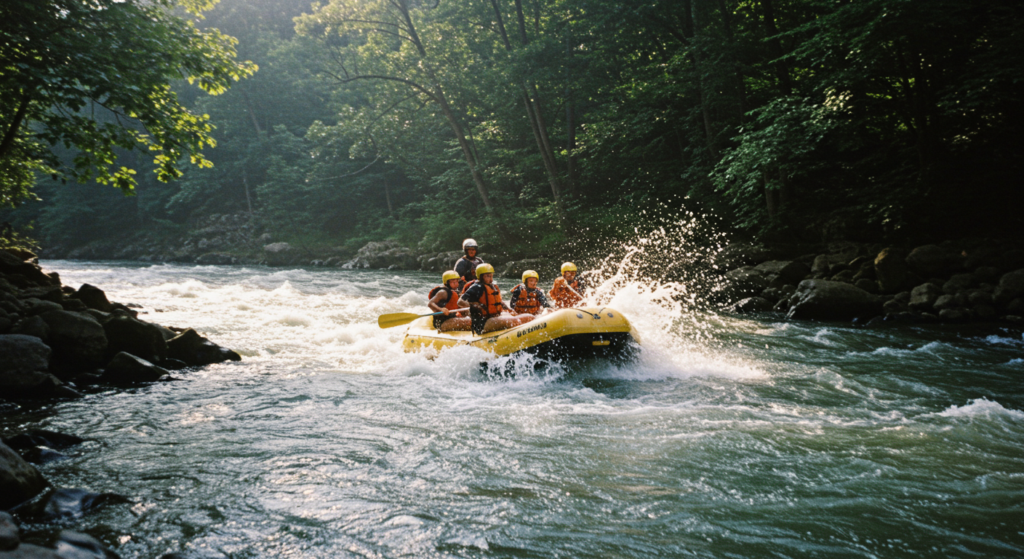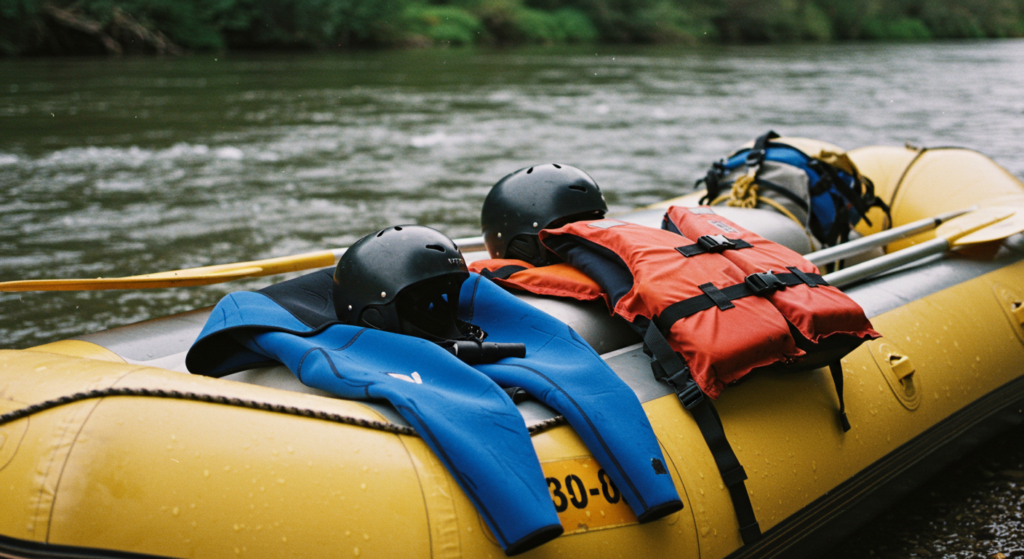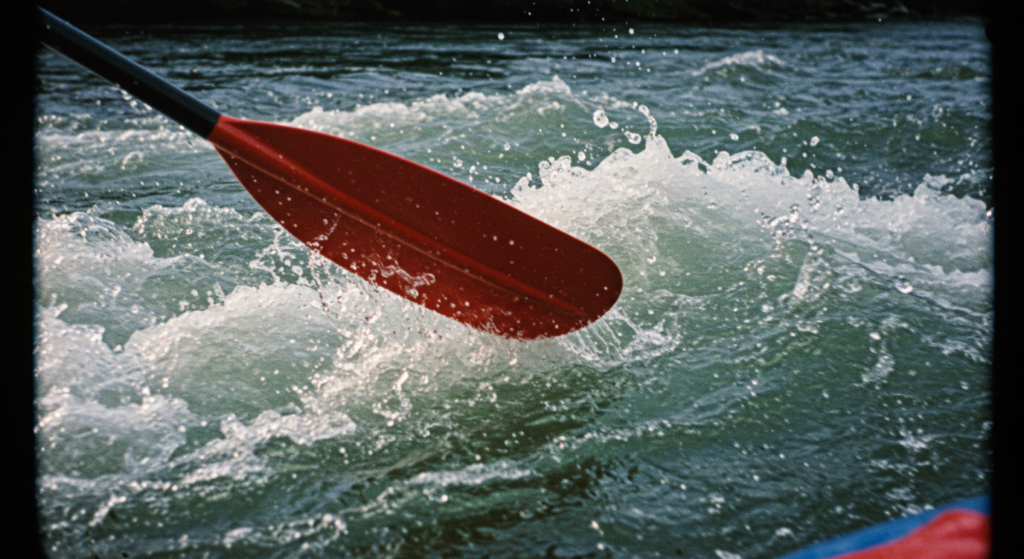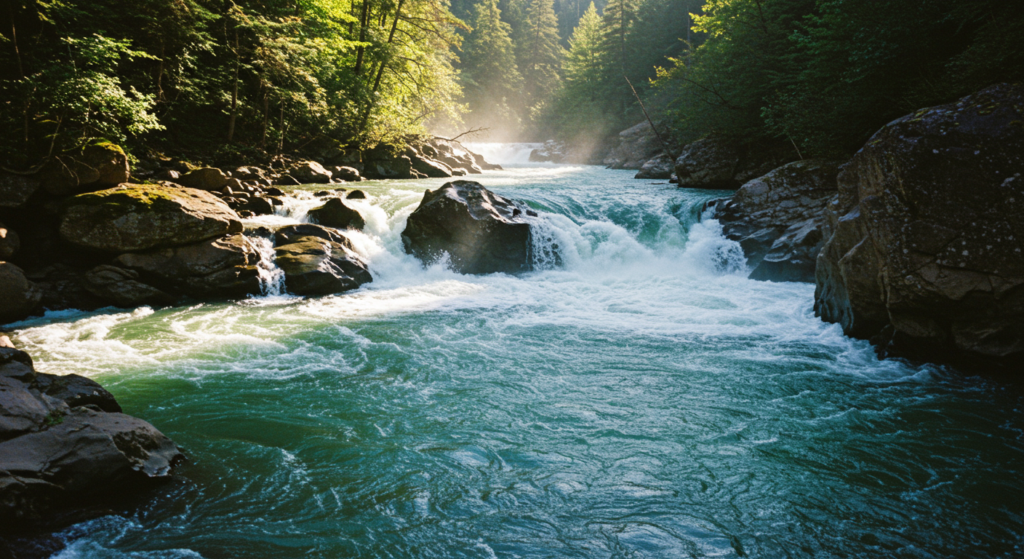White Water Rafting Made Easy
Have you ever dreamt of navigating rushing rivers, feeling the spray of cool water on your face, and conquering thrilling rapids? Whitewater rafting might be your perfect adventure! This exhilarating sport isn’t just about adrenaline – it’s a chance to connect with nature’s raw power, challenge yourself physically and mentally, and forge unforgettable memories with friends and family.
While the image of whitewater rafting might conjure visions of seasoned thrill-seekers, the good news is that this activity is accessible to a wider audience than you might think. Whether you’re a seasoned athlete or a weekend adventurer, there are trips available to cater to all experience levels.
However, a little preparation goes a long way, especially for first-timers. This guide will equip you with everything you need to know to embark on your whitewater rafting adventure with confidence. We’ll delve into the different types of rapids you might encounter, the essential gear to bring, safety protocols, and tips for choosing the perfect rafting trip for your skill level. So, grab your sense of adventure, buckle up, and get ready to experience the exhilarating world of whitewater rafting!
Know Yourself, Know the River: Choosing the Right Rapids for Your Rafting Debut

Not all whitewater rapids are created equal, and just like your favorite hiking trail comes in easy, moderate, and challenging difficulties, so too do rivers offer a spectrum of experiences. Before you grab your paddle and hit the water, it’s crucial to understand your own skill level and choose a river with rapids that match your ability and comfort zone.
Rapid Classification: A Compass for Your Adventure
Choosing the right whitewater rafting trip is all about finding the perfect balance between challenge and enjoyment. Just like hiking trails come in easy, moderate, and difficult variations, rivers offer a spectrum of experiences based on the difficulty of their rapids. Here’s where the International Rapid Classification System comes in – a handy roadmap that categorizes rapids on a scale of Class I to Class VI, helping you pick a trip that aligns with your skill level and thirst for adventure. Let’s navigate this scale together and see which rapids are the perfect match for your next aquatic escapade:
- Class I: Gentle Floats for Families and First-Timers
Think of Class I rapids as the lazy river of the whitewater world. These are calm stretches of water with minimal challenge, perfect for a scenic float trip. Expect small waves, gentle ripples, and maybe a few splashy sections – nothing that a good life jacket and a sense of fun can’t handle. Class I rapids are ideal for families with young children or anyone seeking a relaxing introduction to the world of whitewater rafting. - Class II: Splashy Fun with a Touch of Maneuvering
Step up your excitement level a notch with Class II rapids. These offer a taste of whitewater thrills with some easy-to-navigate rapids featuring clear channels and splashy waves. Be prepared to get a little wet – it’s all part of the exhilarating experience! While some basic maneuvering might be required with your paddle, a good guide will steer you through any obstacles, ensuring a fun and manageable ride. Class II rapids are a great choice for beginners who want a slightly more adventurous experience. - Class III: Get Ready for Bumps and Braces!
Hold on tight – things start to get interesting with Class III rapids! Expect moderate rapids with more technical sections that require some teamwork and maneuvering. These rapids might have swifter currents, small ledges, or unpredictable waves, but don’t worry – a skilled guide will be there to navigate you through the trickier sections. Be prepared for some bumps, splashes, and maybe even a few exhilarating drops. Class III rapids are ideal for those who want a challenge but are still building their whitewater confidence. - Class IV: Bigger Waves, Bigger Thrills (and Bigger Skill Required)
Calling all adrenaline junkies! Class IV rapids are where the excitement truly ramps up. Imagine powerful waves, significant drops, and technical maneuvers that demand a strong team effort and a skilled guide. These rapids require confident paddling skills, good balance, and the ability to follow instructions quickly. Expect an exhilarating ride with an emphasis on teamwork and navigating more challenging obstacles. Only consider Class IV rapids if you have some prior whitewater experience and a good level of fitness. - Class V: Welcome to the Expert Zone – Proceed with Caution
If you’re a seasoned rafter seeking the ultimate whitewater challenge, then Class V rapids are your playground. These are extremely difficult and dangerous stretches of water with large drops, chaotic currents, and unpredictable hazards. Successful navigation requires expert-level skills, exceptional teamwork, and the ability to think quickly under pressure. Before attempting Class V rapids, you’ll need extensive whitewater experience, top-notch physical fitness, and the guidance of a highly qualified professional. - Class VI: Uncharted Territory for the Most Daring Adventurers
Considered the Mount Everest of whitewater rafting, Class VI rapids are virtually untamed and often unexplored. These are extremely dangerous stretches of water with features that have never been successfully rafted, or may even be considered un-runnable. Only the most experienced and daring rafters, with a near-suicidal sense of adventure, would even consider attempting a Class VI rapid. For most of us, these rapids exist purely in the realm of legend and should be admired from a safe distance.
Remember, the difficulty of a rapid can also be influenced by water flow. Higher water flow generally translates to more challenging rapids. Always choose a river and a guide that aligns with your skill level and prioritize safety above all else. With the right preparation and a sense of adventure, you’re sure to find the perfect whitewater rafting experience to match your abilities and create memories that will last a lifetime!
Dress For The Rapids

Conquering whitewater rapids is an exhilarating adventure, but it’s important to remember that safety is always the top priority. The right gear is like your trusty armor on this aquatic odyssey, ensuring you stay comfortable, protected, and ready to take on the challenges of the river.
Your Body’s Shield: Wetsuit or Drysuit?
The first line of defense against the chilly embrace of river water is your thermal protection. Depending on the water temperature and air conditions, you’ll likely choose between a wetsuit or a drysuit. Wetsuits, made from neoprene, are like second skins that trap a thin layer of water next to your body, keeping you warm through its insulating properties. Drysuits, on the other hand, are watertight suits that create a complete barrier between you and the elements. They’re ideal for colder water temperatures or longer rafting trips, keeping you completely dry and comfortable throughout your adventure.
Stay Afloat with Confidence: Your Life Jacket
This isn’t your childhood pool floatie – a Personal Flotation Device (PFD) is a crucial piece of safety equipment that can literally save your life. Life jackets come in various styles and functionalities, but they all share the same core purpose – to keep you afloat if you end up in the water. Choose a PFD that fits snugly but comfortably, allowing for freedom of movement while paddling. Look for features like adjustable straps and multiple buckles for a secure fit, and don’t forget to check the U.S. Coast Guard certification to ensure it meets safety standards.
Helmet Up for Adventure: Protecting Your Most Important Asset
Your head is your command center, so protecting it during a whitewater adventure is paramount. A properly fitted helmet shields you from potential bumps and scrapes against rocks or other obstacles you might encounter on the river. Choose a helmet designed specifically for whitewater rafting, made from impact-resistant materials and featuring an adjustable chin strap for a secure fit.
Remember, the right gear is an investment in your safety and enjoyment. Don’t hesitate to ask your rafting company for recommendations or sizing assistance to ensure you have everything you need to conquer the rapids with confidence and comfort. In the next section, we’ll delve into some essential pre-trip preparations and safety protocols to keep your whitewater adventure running smoothly.
Listen to your guide and follow instructions
Your guide is an experienced professional who knows the river and its rapids well. It is important to listen carefully to their instructions and follow their guidance to ensure your safety and the safety of your fellow rafters. You should also ask questions if you are unsure about anything, and be open to feedback and advice from your guide.
Learn the basics of paddling and maneuvering the raft

While the raw power of the river provides the thrills, navigating those whitewater rapids requires teamwork and a fundamental understanding of paddling techniques. Before you hit the churning water, your qualified guide will be your rafting sensei, teaching you the essential strokes that will transform you from a passenger to a paddling pro.
Your trusty paddle is like an extension of your arm, the tool that will propel you through the water and help you maneuver the raft. Learn the proper grip techniques – imagine holding the T-grip with your dominant hand on top and your other hand comfortably down the shaft for optimal control. The three basic strokes to get you from point A to point B.
- Forward Paddle Power – This is your bread-and-butter stroke, the one you’ll use most frequently to propel the raft forward. Engage your core and upper body muscles as you dip the blade of the paddle into the water ahead of you, then take a powerful stroke back, pulling the water towards your body. Coordinate your paddling with your fellow crewmates to ensure smooth, efficient movement.
- The Backstroke for Control – While the forward paddle is for driving forward, the backstroke is your secret weapon for navigating obstacles and controlling the raft’s direction. Place the paddle blade in the water behind you and push it forward with your core and arms, using the raft itself as leverage to turn or slow down.
- The J-Stroke for Maneuvering Tight Spots – Imagine the letter J – that’s the path your paddle blade takes in this maneuver. With the blade in the water near the front of the raft, sweep it outwards in a J-shaped motion, pushing the water away from the raft and guiding it around obstacles or towards calmer sections.
Remember, you’re not in this alone! Rafting is a team effort, and synchronized paddling is key to navigating the rapids effectively. Listen to your guide’s commands, pay attention to your fellow paddlers, and coordinate your strokes to achieve a smooth and efficient journey down the river.
Practicing these techniques on calmer water before hitting the rapids will boost your confidence and ensure you’re prepared to tackle any challenges the river throws your way. Remember, a little preparation goes a long way in transforming you from a rafting rookie to a paddling pro, ready to conquer the whitewater with skill and teamwork! In the next section, we’ll explore some essential safety protocols to keep your adventure running smoothly.
Be prepared to fall out of the raft
Whitewater rafting is exhilarating, but it’s important to be realistic – sometimes, the thrill of the rapids translates into an unplanned swim. While falling out isn’t necessarily a cause for panic, it’s crucial to be mentally prepared and know how to handle the situation calmly and effectively.
Accepting the possibility of a swim beforehand can help ease anxiety and allow you to focus on enjoying the ride. Think of it as an potential adventure within the adventure, a chance to put your water safety skills to the test.
This trusty piece of equipment is your lifeline. Ensure your PFD is snug but comfortable, allowing for freedom of movement while paddling. Remember, a properly fitted life jacket will keep you afloat, giving you time to focus on getting back to the raft or the safety boat.
If a rapid throws you overboard, try to stay calm. Fight the urge to flail or panic, as this can expend valuable energy and make it harder to stay afloat. Focus on keeping your head above water and orienting yourself towards the current.
The goal is to get back to the raft or the safety boat as quickly and safely as possible. If you can, use the current to your advantage, allowing it to guide you towards the calmer water on the side of the river. Remember, don’t try to fight the current head-on – this will only tire you out.
If you’re struggling to get back to the raft or the safety boat, don’t hesitate to signal for help. Raise your arm and call out for assistance – your guide and fellow rafters will be there to support you.
Your Backup on the Water: Most reputable rafting companies employ a safety boat that follows the raft throughout the trip. This boat is there to assist rafters who fall out and ensure everyone’s safety on the river. If you end up in the water, the safety boat will be there to pick you up and get you back to the raft as quickly and safely as possible.
By understanding the possibility of a fall, wearing your PFD properly, and knowing how to stay calm and navigate the water, you’ll be well-equipped to handle an unexpected swim with confidence. Remember, even Olympic swimmers take tumbles – the key is to stay focused, utilize your safety training, and trust your guide and fellow rafters to get you back on board. In the next section, we’ll explore some additional safety protocols to ensure a smooth and enjoyable whitewater rafting experience.
Stay hydrated and nourished
Conquering whitewater rapids is an exhilarating adventure, but it’s also a physical feat. The combination of paddling, maneuvering the raft, and battling the current can leave you feeling parched and depleted if you’re not properly fueled. Here’s how to stay hydrated and energized throughout your rafting journey:
Water is your best friend on the river. Dehydration can quickly zap your energy levels, cloud your judgment, and lead to unpleasant headaches. Even if you don’t feel particularly thirsty, sip on water regularly throughout the trip. Most rafting companies will provide coolers for storing water bottles – bring a reusable one labeled with your name to avoid confusion. Consider adding electrolyte tablets to your water, especially on hot days or longer trips, to replenish essential minerals lost through sweat.
Don’t skimp on breakfast! Fuel your body for the adventure ahead with a nutritious and balanced meal. Think complex carbohydrates for sustained energy, like oatmeal or whole-wheat toast with lean protein like eggs or yogurt. Avoid sugary cereals or pastries – they’ll give you a quick burst of energy followed by a crash that will leave you feeling sluggish on the water.
Pack high-energy snacks to keep your blood sugar levels stable throughout the day. Good options include nuts, granola bars, dried fruit, or energy bars. Avoid greasy or processed foods that can sit heavy in your stomach. Small, frequent snacks are better than overloading before hitting the rapids.
Hydration and nourishment are essential, but it’s also important to listen to your body’s cues. If you’re feeling particularly famished, don’t hesitate to ask your guide for a quick snack break. They’ll be happy to accommodate your needs and ensure you have enough fuel to conquer the rest of the rapids.
By staying hydrated and strategically snacking on energizing foods, you’ll be well on your way to a fun-filled and action-packed whitewater adventure. Remember, a happy stomach equals a happy rafter, so pack smart and fuel your body for the thrills that await! In the next section, we’ll explore some essential safety protocols and etiquette tips to ensure a smooth and enjoyable experience for everyone on the river.
Respect the environment

White water rafting takes place in natural environments, and it is important to respect and protect these environments. You should avoid littering and follow Leave No Trace principles. This includes packing out all your trash, using biodegradable soap, and avoiding disturbing wildlife.
Choose a reputable white water rafting company
The churning river, the thrill of the rapids – it’s all undeniably exciting, but embarking on a whitewater adventure requires a foundation of trust and safety. That’s where your rafting company comes in – your partner in navigating the currents and ensuring an unforgettable experience. Here’s how to choose a reputable company that prioritizes safety, fun, and an overall epic adventure:
Look for a company with a proven track record. Years of experience on the river translate to a deep understanding of the rapids, potential hazards, and the safest routes to navigate. Seek out companies with a team of highly trained and certified guides who possess not only the technical skills but also the ability to instill confidence and camaraderie among rafters.
A reputable rafting company will provide top-notch equipment that’s essential for a safe and comfortable journey. This includes well-maintained rafts, properly sized life jackets, helmets, and any other gear required for the specific river conditions. Don’t be afraid to ask about their equipment – transparency and a commitment to using high-quality gear are hallmarks of a trustworthy outfitter.
Safety should never be a compromise. Choose a company with a strong safety record that prioritizes guest wellbeing above all else. Look for certifications from recognized rafting organizations and inquire about their safety protocols, emergency procedures, and guide training programs. A company that prioritizes safety briefings and clear communication is one you can trust on the water.
Reviews and Ratings In today’s digital age, online reviews and ratings can be a treasure trove of information. Take some time to research the rafting company you’re considering. Read reviews from past guests, paying attention to their experiences with the guides, the quality of the trip, and the overall safety measures in place.
Finding the Right Fit While safety is paramount, consider what kind of experience you’re seeking. Do you crave an adrenaline-pumping adventure, or are you looking for a more scenic float trip with a touch of excitement? Many companies offer trips catering to different experience levels and preferences. Look for a company whose offerings align with your desired level of challenge and the overall atmosphere you’re hoping to create.
Choosing a reputable whitewater rafting company is an investment in your safety and enjoyment. By prioritizing experience, top-notch gear, a strong safety record, and finding the right fit for your adventure goals, you’ll be well on your way to a whitewater rafting experience that will leave you exhilarated, empowered, and ready to conquer your next challenge. In the next section, we’ll explore some essential safety protocols and etiquette tips to ensure a smooth and enjoyable experience for everyone on the river.
Discover the Essentials of White Water Rafting for Beginners
White water rafting can be a thrilling and unforgettable experience for beginners. It’s important to choose an appropriate river based on your skill level, wear the right gear, listen to your guide, learn basic paddling and maneuvering techniques, be prepared to fall out of the raft, stay hydrated and nourished, respect the environment, and choose a reputable rafting company. By following these guidelines, you can have a safe and enjoyable white water rafting experience that you’ll remember for a lifetime. So, get ready to explore the rapids and have an adventure of a lifetime!
